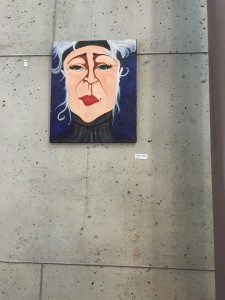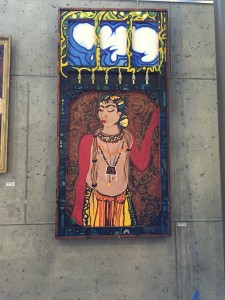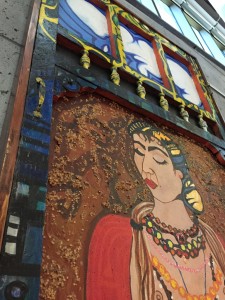Growing up in an Asian family, I’ve never had the opportunity to go to an art show or a museum. Unless I was required to go in order to complete an assignment, I usually looked up pictures on Google. In fact, I still remember searching up paintings by Rembrandt, or pictures from the baroque or impressionist periods. And as much as I wouldn’t like to admit, my interest at that time was to complete a graded assignment.
Fortunately, I was given the opportunity to attend my first art show ever, featuring artist Nicholas Lawson Carbonaro. Now living in Ithaca, he used to live in New York, which had influenced most of the pieces that were put on display. His works were hung along the wall opposite of the entrance to the dining hall, and interestingly enough, he told me that he had specifically chosen that place so people walking outside would be able to admire his art through the windows.
After taking a short tour along the wall, I noticed that most of the pieces were made in different years, with ones that dated from the late 1990’s to 2013. Though this collection is not representative of his whole career as an artist, Nicholas mentioned that they particularly stood out to him and he deliberately chose from different years to showcase his thoughts about the progression of life.
Personally, the highlight of the art show was to be able to strike a conversation with the artist himself. As an outsider, I can only tell so much of one’s life through art. Take the first photo on the right, for instance, which featured a portrait on a tinier canvas compared to the others. At first, I thought the woman looked like a renowned super villain who would star in a cartoon or movie. But it turned out that the person featured in the painting ‘Rose’, was actually his grandmother! Furthermore, this was created during his recovery from kidney surgery, since he couldn’t really maneuver bigger and heavier canvases. Isn’t his grandmother so cool?!
 ‘Rose’ – 2013
‘Rose’ – 2013
Another piece I admired was ‘Welcome to My Home’. In some museums, there’s a bit of a distance between the viewer and the canvas hanging from the wall to prevent any damages from occurring. However, Nicholas invited me to take a closer look and he later told me that the canvas for this painting was a Victorian style door that was flipped over and repainted! It was solid wood! (And upon inspection, I noticed that this painting had what I thought were pepper seeds? Though I didn’t have the opportunity to ask him about why he had decided to use them as part of his media.)
 ‘Welcome to My Home’ -2002
‘Welcome to My Home’ -2002
 ‘Welcome to My Home’ – 2002
‘Welcome to My Home’ – 2002
All in all, it was incredible to meet Nicholas in person and to be able to learn about the deep connections he had with each and every one of his works. To the audience, some of them might just be a painting. But now I understand that they hold a cherished story in his life and I’m glad Nicholas had decided to share it with us.
Also, if anyone wants to get a haircut or new hairdo, you can find him at Studio 108 in College Town! He works as a hairstylist too!



